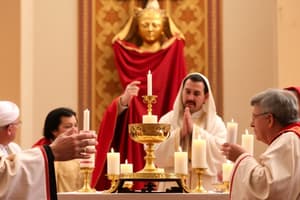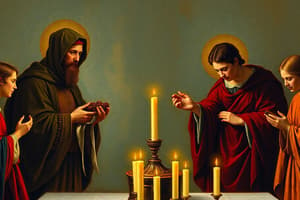Podcast
Questions and Answers
What is the primary purpose of the Eucharist as instituted by Christ?
What is the primary purpose of the Eucharist as instituted by Christ?
- To thank God for creation and redemption.
- To reenact the sacrifice of the cross throughout time. (correct)
- To provide moral lessons to followers.
- To serve as a community gathering.
Which of the following accurately describes the minister of the Eucharist?
Which of the following accurately describes the minister of the Eucharist?
- A choir director can also perform Eucharistic minister duties.
- The minister acts in persona Christi, representing Jesus Christ. (correct)
- Only apostles can serve as ministers of the Eucharist.
- Any baptized Christian may administer the Eucharist.
What event is commemorated during the Paschal Triduum?
What event is commemorated during the Paschal Triduum?
- The incarnation of Jesus Christ
- The passion, death, and resurrection of our Lord (correct)
- The birth of Jesus Christ
- The ascension of Jesus into heaven
What aspect of the Mass distinguishes it as a memorial of Christ's Sacrifice?
What aspect of the Mass distinguishes it as a memorial of Christ's Sacrifice?
Which season marks the preparation for Christ's second coming?
Which season marks the preparation for Christ's second coming?
What does the term 'eucharistein' emphasize in the context of the Eucharist?
What does the term 'eucharistein' emphasize in the context of the Eucharist?
What is the primary purpose of the Tabernacle in a church?
What is the primary purpose of the Tabernacle in a church?
During which part of the Mass does the bread and wine become the Body and Blood of Christ?
During which part of the Mass does the bread and wine become the Body and Blood of Christ?
What does the season of Lent traditionally focus on for the faithful?
What does the season of Lent traditionally focus on for the faithful?
Which liturgical season begins the cycle with the first Sunday of Advent?
Which liturgical season begins the cycle with the first Sunday of Advent?
Flashcards are hidden until you start studying
Study Notes
The Eucharist
- The Eucharist is a Sacrament where Catholics consume the Body and Blood of Christ, reenacting his sacrifice on the cross. It was instituted by Jesus during the Last Supper in Jerusalem.
- The purpose of the Eucharist is to perpetuate Christ's sacrifice throughout history and to bring communion between humanity and God through the consumption of His Body and Blood.
- The Eucharist is the memorial of Christ's sacrifice, meaning it is the re-enactment of the one-time sacrifice made 2000 years ago.
- The Eucharist is meant to be a "thanksgiving" to God for the beauty of creation and the miracle of redemption.
- The ministers of the Eucharist are the priests and bishops who act "in persona Christi" (in the person of Christ).
- During the consecration, bread and wine transform into the Body and Blood of Christ, mirroring the words spoken by Jesus during the Last Supper: "This is my body...this is my blood" (Matthew 26:26-28).
- The transubstantiation is the process by which the bread and wine change substance into the Body and Blood of Christ during consecration.
- The Tabernacle is the sacred space in the church where the consecrated Hosts are kept. It must be placed in a prominent and worthy location to reflect the true presence of Christ in the Blessed Sacrament.
The Liturgical Year
- The Liturgical Year is a 12-month cycle that celebrates the mystery of Christ. It begins on the First Sunday of Advent and ends on the Solemnity of Christ the King.
- There are six separate seasons within the Liturgical Year: Advent, Christmas Time, Lent, Paschal Triduum, Easter Time, and Ordinary Time.
- Advent marks preparation for the two-fold coming of Christ: His birth in Bethlehem and His return at the end of time. It begins four Sundays before December 25th and ends with the Christmas Vigil Mass.
- Christmas Time celebrates Jesus' birth, beginning at the Vigil Mass on Christmas Eve and ending on the Feast of the Baptism of the Lord. The colors used during this time are white or gold to represent joy.
- Lent is a time of preparation for Easter, the most important feast in the Church, where individuals focus on spiritual growth through prayer, fasting, and almsgiving. It is also a time for catechumens to prepare for the sacraments of initiation.
- The Paschal Triduum celebrates the Passion, Death, and Resurrection of Christ. It starts with the Evening Mass of the Lord's Supper on Holy Thursday, continuing through Good Friday with the celebration of the Passion of the Lord, culminating in the Easter Vigil on Saturday night.
- Easter Time celebrates the resurrection, ascension, the coming of the Holy Spirit, and the birth of the Church.
- Ordinary Time is the period outside of the major seasonal celebrations, beginning with the Baptism of the Lord and ending on the Feast of Christ the King.
Liturgical Colors
- Green: The color of hope, life, and vegetation. Used during Ordinary Time.
- Red: The color of blood, used during celebrations of the Passion, feasts of Apostles and Martyrs, Pentecost, and Masses of the Holy Spirit.
- Violet: The color of penance and mourning, used during Advent, Lent, and funerals.
- White: The color of purity, innocence, and victory, used during feasts of the Lord, Virgin Mary, angels, and saints who were not martyrs.
- Gold: The color of royalty, it replaces white, red, or green in special circumstances.
- Rose: The color of joy and moderation, used on the Third Sunday of Advent (Gaudete) and the Fourth Sunday of Lent (Laetare).
Sacred Vestments
- Cassock: A close-fitting ankle-length garment worn by clergy and lay people during liturgical services.
- Cotta: A waist-length surplice worn over the cassock by clergy and lay people during liturgical services.
- Alb: A long, white linen garment worn by priests, symbolizing the purity and innocence expected of them when ascending the altar.
- Stole: A long scarf worn by priests around the neck, representing their priestly service and the immortality of the soul.
- Chasuble: The outer priestly vestment, symbolizing charity and selfless service to the Lord.
- Cope: A vestment worn over the shoulders and hands by the priest during processions and Eucharistic adoration.
- Deacon's Stole: Worn diagonally by deacons.
- Dalmatic: A sleeved tunic worn by a deacon in place of the Chasuble.
Sacred Books
- Missal: The book containing all the prayers and rites used by the priest during Mass. It is kept on the altar.
- Lectionary: The book that contains all the readings used during Mass. Leveled readings are meant for lay people, with the Gospel reserved for priests or deacons. The lectionary is kept on the ambo.
- Book Of The Gospels: Also called "Evangelarium", this book contains only the Gospel readings. It is brought in procession and placed on the altar. After the Alleluia, it is brought to the ambo for the proclamation of the Gospel.
Sacred Vessels
- Paten: A small plate of precious metal used to hold the large Host.
- Chalice: A cup of precious metal, usually gold or gold-plated, used to hold the consecrated wine during Mass.
- Ciborium: A vessel that holds Hosts for distribution to the faithful.
- Cruets: Two vessels containing the wine and water used for the Eucharist.
- Monstrance: A vessel used for exposing the consecrated Host for adoration.
- Thurible/Censer: A covered incense burner swung on chains during Mass, processions, and Eucharistic adoration.
- Incense-Boat: A container for the incense offered during Mass.
Sacred Linens
- Altar Cloth: A linen cloth placed on the altar for Mass.
- Purificator: A small linen cloth used to dry the priest's fingers and the chalice.
- Corporal: A linen cloth spread on the altar to collect any drops of blood or host fragments.
- Pall: A small, stiffened square of linen used to cover the chalice.
Eucharistic Symbols
- Alpha & Omega: The first and last letters of the Greek alphabet, signifying that Christ is "the beginning and the end" of creation (Revelation 22:13).
- Pelican: Represents Jesus shedding his blood for our salvation. This is based on the belief that pelicans feed their chicks with their own blood by wounding their breasts when no other food is available.
- Ichthys: The Greek word for fish, an acrostic for "Iesous Xhristos THeou Uios Soter" (Jesus Christ God's Son Savior). A popular symbol among Christians during Roman persecution due to its discreet nature.
- IHS: An acronym for the Latin "Iesus Hominum Salvator" (Jesus Men's Savior), promoted by the preachings of St. Bernardine of Siena.
- Latin Cross: An empty cross, favored by Protestants, representing the resurrection of Christ.
- Crucifix: A cross with Jesus on it, favored by Catholics and Orthodox, representing Christ's suffering and sacrifice.
- Chi-Rho: A symbol made by superimposing the first two letters of Christ in Greek, Chi (X) and Rho (R), which Emperor Constantine saw in the sky, believed to be a sign of victory.
- INRI: The Latin abbreviation for "Iesus Nazarenus Rex Iudaeorum" (Jesus of Nazareth, King of the Jews), placed above Jesus' head on the cross. (John 19:19)
- Lamb: Represents Jesus as the "Lamb of God" who was slain but lives forever (Revelation 5:6).
Studying That Suits You
Use AI to generate personalized quizzes and flashcards to suit your learning preferences.




